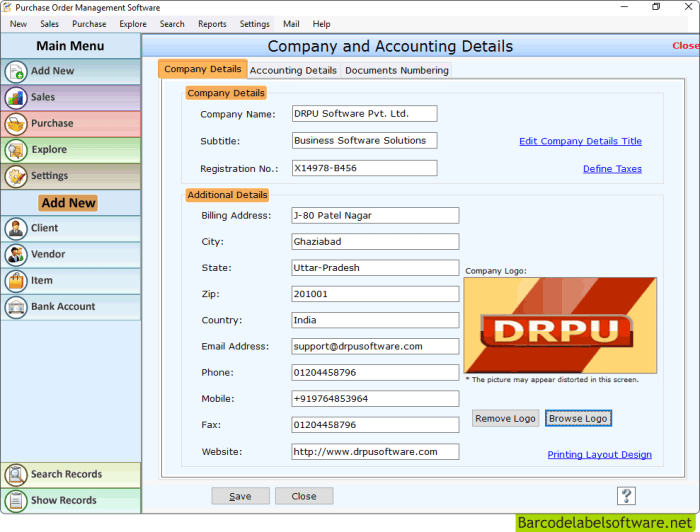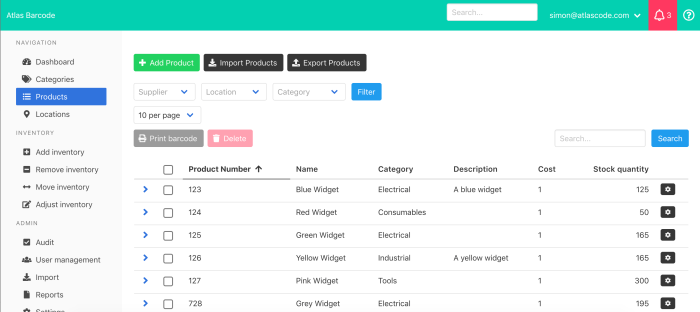Purchase order and inventory management software revolutionizes how businesses handle procurement and stock control. Efficiently managing purchase orders streamlines the entire supply chain, from initial requisition to final payment. Simultaneously, robust inventory tracking minimizes stockouts, reduces waste, and optimizes storage space. This integration allows for better forecasting, data-driven decisions, and ultimately, increased profitability.
The software’s features often include automated purchase order generation, real-time inventory updates, supplier management tools, reporting and analytics dashboards, and integration with accounting systems. This comprehensive approach reduces manual errors, minimizes discrepancies, and enhances overall operational efficiency. The benefits extend beyond simple organization, impacting financial performance and strategic planning.

Source: barcodelabelsoftware.net
In today’s fast-paced business environment, efficient inventory management is paramount. Losing track of stock, experiencing stockouts, or overstocking can significantly impact profitability and customer satisfaction. This is where integrated purchase order and inventory management software steps in, offering a powerful solution to optimize your supply chain and boost your bottom line. This detailed guide explores the intricacies of such software, its benefits, key features, and how to choose the right system for your business needs.
Understanding Purchase Order and Inventory Management Software
Purchase order and inventory management software, often integrated into a single system, automates and streamlines the entire process from ordering supplies to tracking inventory levels. This eliminates manual processes, reduces errors, and provides real-time visibility into your inventory. The software integrates purchase order creation, vendor management, receiving, stock tracking, and reporting functionalities into a centralized platform. This allows for better control over costs, improved forecasting, and ultimately, increased efficiency.
Key Features of Effective Software, Purchase order and inventory management software
- Purchase Order Management: Automated purchase order generation, tracking, and approval workflows. This includes features like customizable templates, vendor communication tools, and automated reminders for overdue orders.
- Inventory Tracking: Real-time tracking of inventory levels across multiple locations, using various methods like barcode scanning, RFID, or manual entry. This enables accurate stock counts and helps prevent stockouts or overstocking.
- Vendor Management: Centralized database of vendors with contact information, purchase history, and performance metrics. This simplifies communication and allows for better vendor relationship management.
- Reporting and Analytics: Comprehensive reporting features that provide insights into inventory trends, sales data, and purchasing patterns. This allows businesses to make data-driven decisions and optimize their inventory strategies.
- Integration with other systems: Seamless integration with accounting software, e-commerce platforms, and other business applications for a streamlined workflow. This minimizes data entry and improves overall efficiency.
- Demand Forecasting: Predictive analytics to forecast future demand based on historical data and market trends. This helps businesses optimize inventory levels and reduce carrying costs.
- Low Stock Alerts: Automated alerts for low stock levels, enabling timely reordering and preventing stockouts.
- Lot and Serial Number Tracking: For businesses handling products with lot numbers or serial numbers, this feature ensures accurate tracking and traceability throughout the supply chain. This is especially critical in industries with strict regulatory requirements.
- Warehouse Management System (WMS) Integration: Integration with a WMS allows for enhanced control over warehouse operations, including receiving, putaway, picking, and shipping.
Benefits of Implementing Purchase Order and Inventory Management Software
The advantages of implementing robust purchase order and inventory management software are substantial and span various aspects of a business. Here are some key benefits:
- Reduced Costs: Minimizes waste from overstocking or stockouts, optimizes purchasing processes, and reduces labor costs associated with manual tasks.
- Improved Accuracy: Eliminates manual errors in inventory counting and purchase order processing, leading to more accurate data and better decision-making.
- Enhanced Efficiency: Automates time-consuming tasks, freeing up staff to focus on other strategic initiatives.
- Better Inventory Control: Provides real-time visibility into inventory levels, allowing for proactive management and preventing stockouts.
- Improved Customer Satisfaction: Ensures timely order fulfillment and reduces instances of backorders, leading to happier customers.
- Increased Profitability: By optimizing inventory levels and reducing costs, businesses can significantly improve their profitability.
- Better Decision Making: Data-driven insights from reporting and analytics enable informed decisions regarding purchasing, inventory levels, and pricing strategies.
- Streamlined Supply Chain: Improved communication and collaboration with vendors, resulting in a more efficient and responsive supply chain.
Choosing the Right Software for Your Business
Selecting the appropriate purchase order and inventory management software requires careful consideration of your specific business needs and requirements. Factors to consider include:
- Business Size and Complexity: Small businesses may require simpler solutions, while larger enterprises may need more sophisticated systems with advanced features.
- Industry-Specific Requirements: Certain industries have unique needs, such as traceability in the food industry or serial number tracking in electronics.
- Budget: Software options range from affordable cloud-based solutions to more expensive on-premise systems.
- Integration Capabilities: Ensure the software integrates seamlessly with your existing accounting and e-commerce systems.
- Scalability: Choose a system that can grow with your business as your needs evolve.
- User-Friendliness: The software should be intuitive and easy to use for all staff members.
- Vendor Support: Reliable customer support is essential to address any issues or questions that may arise.
Frequently Asked Questions (FAQ)
- Q: What is the difference between purchase order software and inventory management software?
A: While often integrated, purchase order software focuses on the process of ordering goods, while inventory management software focuses on tracking and managing stock levels. Integrated solutions offer the best of both worlds. - Q: How much does purchase order and inventory management software cost?
A: Costs vary greatly depending on the features, scalability, and vendor. Options range from free or low-cost cloud-based solutions to more expensive enterprise-level systems. - Q: Can I integrate this software with my existing accounting system?
A: Many solutions offer seamless integration with popular accounting software such as QuickBooks and Xero. Check the software’s compatibility before purchasing. - Q: How long does it take to implement purchase order and inventory management software?
A: Implementation time depends on the complexity of the system and your business processes. It can range from a few days to several weeks. - Q: What are the key performance indicators (KPIs) to track after implementing the software?
A: Key KPIs include inventory turnover rate, stockout rate, order fulfillment time, and carrying costs.
Conclusion
Implementing purchase order and inventory management software is a strategic investment that can significantly improve your business operations and profitability. By automating processes, improving accuracy, and providing valuable insights, this software empowers businesses to optimize their supply chain and achieve greater success. Choosing the right system requires careful consideration of your specific needs and requirements. Take the time to research different options and select a solution that aligns with your business goals.

Source: atlascode.com
References
While specific software recommendations are avoided to remain unbiased, reputable sources for researching inventory management software include:
- Gartner (for industry analysis and vendor comparisons)
- Capterra (for software reviews and comparisons)
- Software Advice (for software reviews and comparisons)
Call to Action
Ready to optimize your inventory management and boost your business efficiency? Explore different purchase order and inventory management software solutions today and take the first step towards a more streamlined and profitable operation!
In conclusion, implementing purchase order and inventory management software offers significant advantages for businesses of all sizes. By automating processes, improving accuracy, and providing valuable insights, this technology empowers organizations to optimize their supply chain, enhance operational efficiency, and ultimately drive greater success. The investment in such software translates to a significant return on investment through cost savings, reduced waste, and improved decision-making.
FAQ: Purchase Order And Inventory Management Software
What are the key benefits of using purchase order and inventory management software?
Key benefits include reduced manual errors, improved accuracy, streamlined workflows, better inventory control, reduced stockouts and overstocking, enhanced forecasting capabilities, and improved financial reporting.
How much does purchase order and inventory management software cost?
Costs vary greatly depending on the software’s features, scalability, and vendor. Pricing models can include one-time purchases, subscription fees, or a combination of both. It’s essential to compare options and consider your specific needs.
Can the software integrate with my existing accounting system?
Many solutions offer seamless integration with popular accounting software packages. However, it’s crucial to verify compatibility before selecting a specific software. Check for API integrations or supported accounting platforms.
What kind of training is required to use the software?
Training requirements vary. Some systems are user-friendly and require minimal training, while others might necessitate more in-depth instruction. Vendors typically offer training resources, including tutorials, documentation, and potentially on-site or online workshops.